How to make your own Sourdough Starter, using simple ingredients with no special equipment, in just six days, that can be used in our sourdough bread. Video.
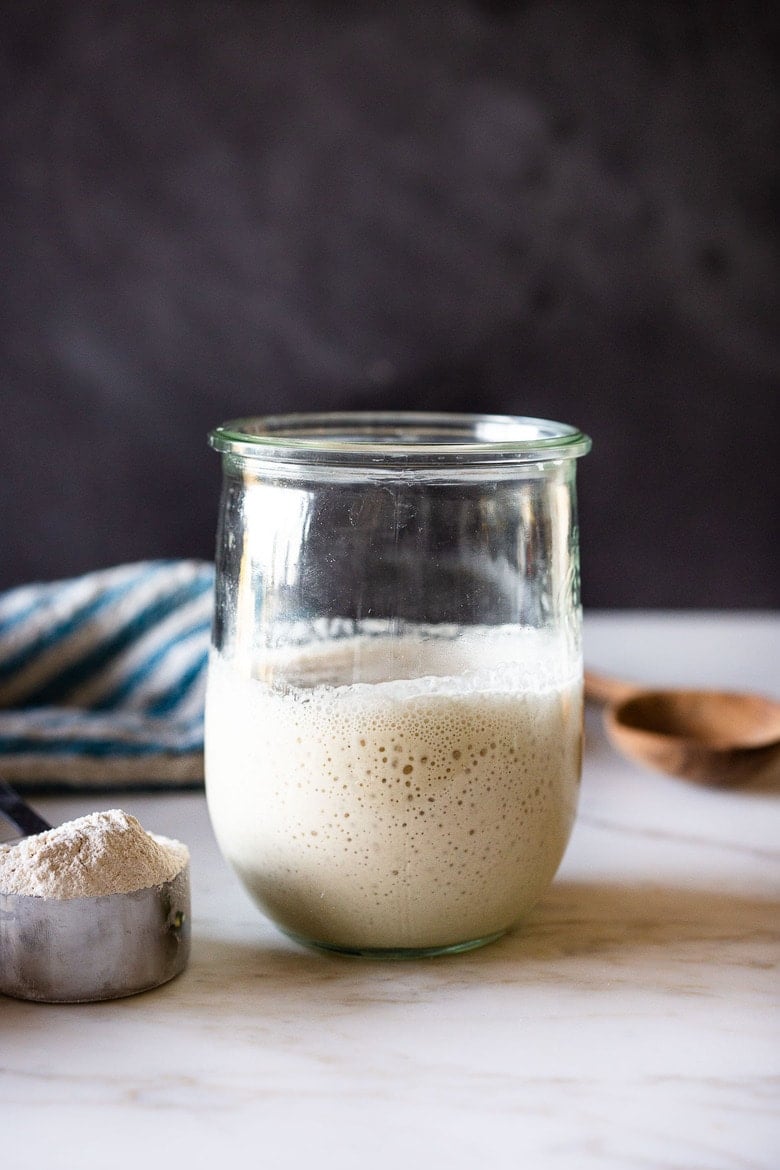
When you understand one thing through and through, you understand everything.~ Shunryu Suzuki
With over 500 five-star reviews and hundreds of success stories, my chef’s perfected sourdough starter guide has everything you need to make your own homemade starter. In just six days, you’ll be baking the most beautiful sourdough loaves!
But first, What is a starter?
Sourdough starter is a “wild yeast” made from flour, water, and the natural wild yeast in the air. With a little care and patience, it ferments, and when strong and active, just a little bit of starter replaces commercial yeast and makes your bread rise, while transforming the gluten in the bread into something more easily digestible. Store-bought yeast is not needed!
How to Make Sourdough Starter | 20-Min Video
***Don’t see the video? Allow 15-20 seconds to load it right here!*** (Still don’t see it? Check that your ad blocker is turned off; use Chrome for the best experience.)
Fast forward to Specific Day by video time (using scroll bar underneath video)
- Day 1 Morning: :23
- Day 2 Morning: 4:10
- Day 3 Morning: 7:00
- Day 3 Evening: 9:12
- Day 4 Morning: 11:50
- Day 4 Evening: 13:37
- Day 5 Morning: 14:45
- Day 6 Evening: 16:50
- Day 6 Morning: 18:12
- Day 6 Evening: 20:10
Sourdough Starter Recipe Ingredients
- Jar – A wide-mouth quart jar or a Weck’s 1-liter tulip jar.
- Flour – 5 lb bag of organic bread flour (plus 1 cup organic whole grain flour )
- Water – filtered water, tap water, or mineral water (specifically, San Pellegrino, for the correct mineral ratio). Distilled water does not have enough minerals.
- Scale – using a kitchen scale is optional but handy.
- Thermometer – Knowing the temp of the starter using a thermometer is optional but handy!
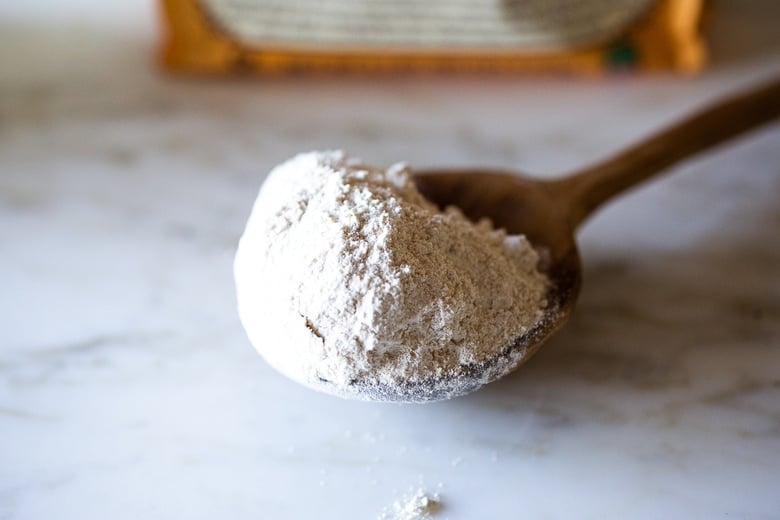
Understanding starter
- Think of sourdough starter as yeast. Only in this case, instead of buying a packet of yeast from the store, you are making your own living “wild yeast” by fermenting flour and water. Once it’s bubbly and happy, it is very much ike a very low-maintenance pet.
- You must feed it (stir in a mixture of flour and water) once a week to keep it active and strong. You know it’s happy when it bubbles. 😉 And YES, you can even name it.
- Some people believe that bread made with sourdough starter is actually better for you than bread made with yeast. Here and Here are a few articles to get you started on your own research. While I’m not sure if this is scientifically proven, I do know that bread made with sourdough starter, tastes infinitely better, feels easier to digest, and has more complexity and better texture, than bread made with commercial yeast. So if you are a bread lover- this is absolutely the way to go, as far as the quality of your finished bread.
How to Make Sourdough Starter
*See the recipe card for detailed instructions.
This recipe for Sourdough Starter takes 6 days (or up to 12 days if it is very cold where you live). For a primer, watch the 20-minute Sourdough Video above!
Day 1: Staring in the morning or at night, using a wide-mouth quart jar, tulip jar, or Crock or Glass Measuring Cup , mix 1 cup whole grain flour (120 grams) with 1/2 cup filtered water (120 grams) using a fork (or chopstick) making sure you’ve incorporated all the dry flour.
Place the lid lightly on top (using the Weck jar lid is really handy here) or a wet towel to keep moisture in, or plastic wrap- and let sit at room temperature (70-ish degrees) on the kitchen counter for 24-48 hours. If you are unsure how warm it is, use a kitchen thermometer and check it a few hours later. See notes for TEMPERATURE.
TIP #1: For your first measurement, weigh the flour using a kitchen scale so you can get an idea of how the mixture should feel. Do not weigh the measuring cup! It should be like a thick paste, like peanut butter. If you need to add a little more water to incorporate the flour, that is OK too!
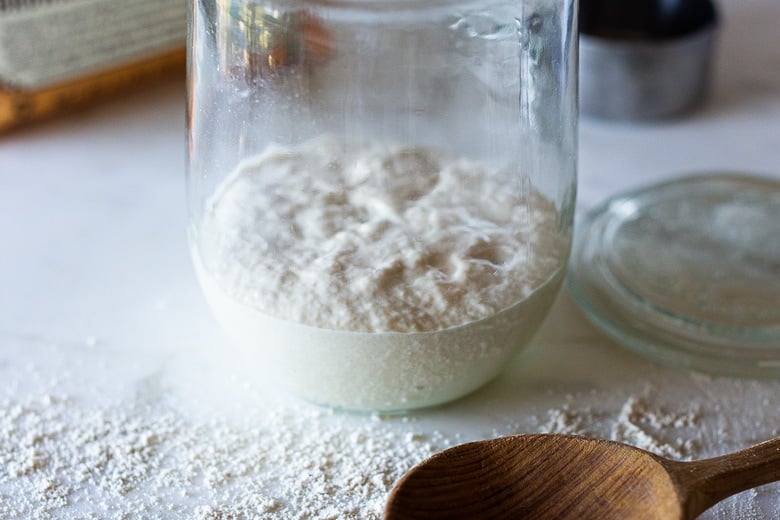
Day 2: After the first 24 hours, there may or may not be a bit of bubbling. Let the mixture rest until you see activity (bubbles or rising) sometimes this takes 36 hours or even 48 hours if very cold. When you see active bubbling, discard all but 1/2 cup of the starter (4 ounces).
To the remaining ½ cup of starter, stir in 1/2 cup water (120 grams), and mix well with a fork. Add 1 cup of organic bread flour (120 grams)spooned and leveled. Stir until combined. Again, it should feel like a thick paste. If overly dry, feel free to add a bit more water. Cover again and allow the mixture to sit at room temperature for another 24 hours.
Day 3: After 24 hours, hopefully, you will see some bubbling or rising and if not, let it go a bit longer until you see activity. Be patient.
Depending on how warm your house is and how active your starter, you may need to begin feeding more often or move to two feedings a day, in the morning and at night. If it is cold, one feeding a day may be enough.
TIP #2: Only feed the starter after it has peaked or looks hungry. See the “3 Signs of Hunger” below. Feeding it when it is “not hungry” will basically dilute all the growing yeast and make it lethargic. Better to underfeed than overfeed.
The 3 Signs of hunger
The photo below was taken after the starter was fed, and after it peaked (reached its highest), and now is sliding down. It is now “hungry” again. See the downward slide marks on the jar? Pay attention – your starter is telling you it is hungry.
- Look for “slide marks” (be sure to use a clean jar so you can see these clearly).
- Liquid at the top of the starter.
- Thin and runny. The starter is liquidy enough to pour out of the jar (when at room temp).

This might be 12 hours, it might be 14, it might be 18, or 24, depending on the temp in your house. In very warm climates, it may only be 6-8 hours. In winter, this may take 36 hours. It is better to underfeed rather than overfeed here.
For each feeding, discard all but 1/2 cup of the starter (keeping roughly ½-cup of starter in the jar). Add 1/2 cup water and 1 cup Bread Flour (spooned and leveled). Mix well, cover, and let this rest at room temperature for 12-24 hours or until the starter looks “hungry” again before repeating.
Day 4: Feed 1-2 times, discarding all but 1/2 cup of starter each time. Feed 1 cup bread flour, 1/2 cup water.
TIP #3: It is typical on day 4 for the starter to slow down and stall a bit. This is OK. Just keep going, be patient and look for the hunger signs, and only feed when clearly hungry. Hopefully, you’ll begin to see some rising and falling. It’s helpful to put the starter in a clean jar each day and mark the beginning level (with a sharpie, string or rubber band) so you can easily see this.
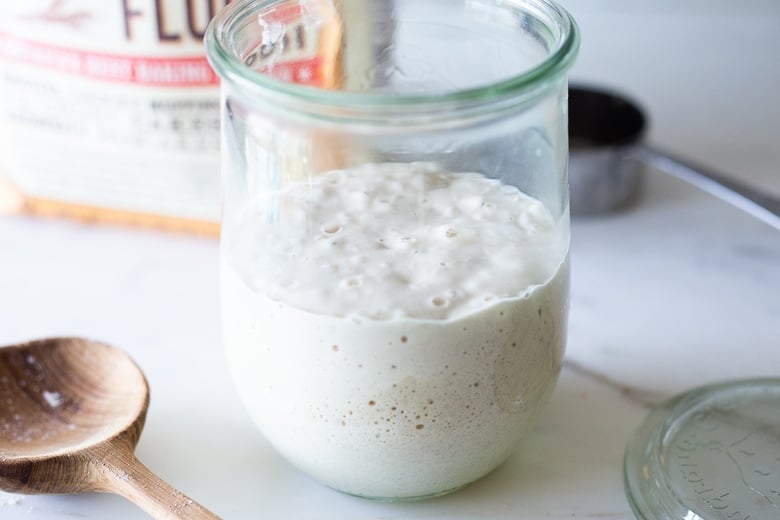
Above, you’ll see it peaking, and below, you’ll see it deflating and getting “hungry.” There may not be too much difference in the beginning, so look closely.
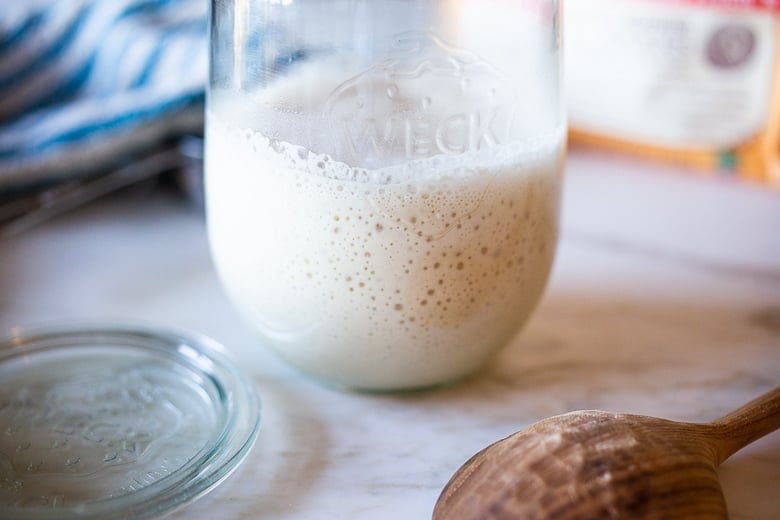
Understand that your starter has a schedule of its own; it is a living thing, so watch it and pay attention.
If your starter is not rising and falling, look at its consistency. As it metabolizes the flour and gets hungry, it will get runny and liquidy, like to the point where you can pour it right out of the jar. If it is still thick like paste, it’s not done metabolizing (eating)the flour.
Day 5: Feed again, 1-2 times, discarding all but a 1/2 cup the starter each time. Adding 1 cup bread flour and 1/2 cup lukewarm water. The starter should look visibly active, bubbling, rising, hopefully, close to doubling in size.
Repeat day 5 until the starter is rising and falling predictably and is close to doubling in size within 6-8 hours.
TIP #4: If your starter is not rising but there is evidence of hunger (liquidy or liquid at the top) try 3 things: substitute 1/4 cup whole grain flour (add to ¾ cup white bread flour) on your next feeding. Try using mineral water like San Pellegrino instead of water. Stir the starter a few times after feeding to allow more wild yeast from the kithcen to get inside.
DAY 6 Morning: Baking day! Give it one last feeding in the morning: this time discard all but a 1/3 cup. (The reason we are changing this to 1/3 cup is to feed it a little bit more.) Add 1 cup flour (120 grams) and 1/2 cup water, stir, and place it in a clean jar so you can see the action clearly. You can use a sharpie or place a rubber band around the jar to mark the beginning level. The starter should hopefully double in volume within 6-8 hours of feeding.
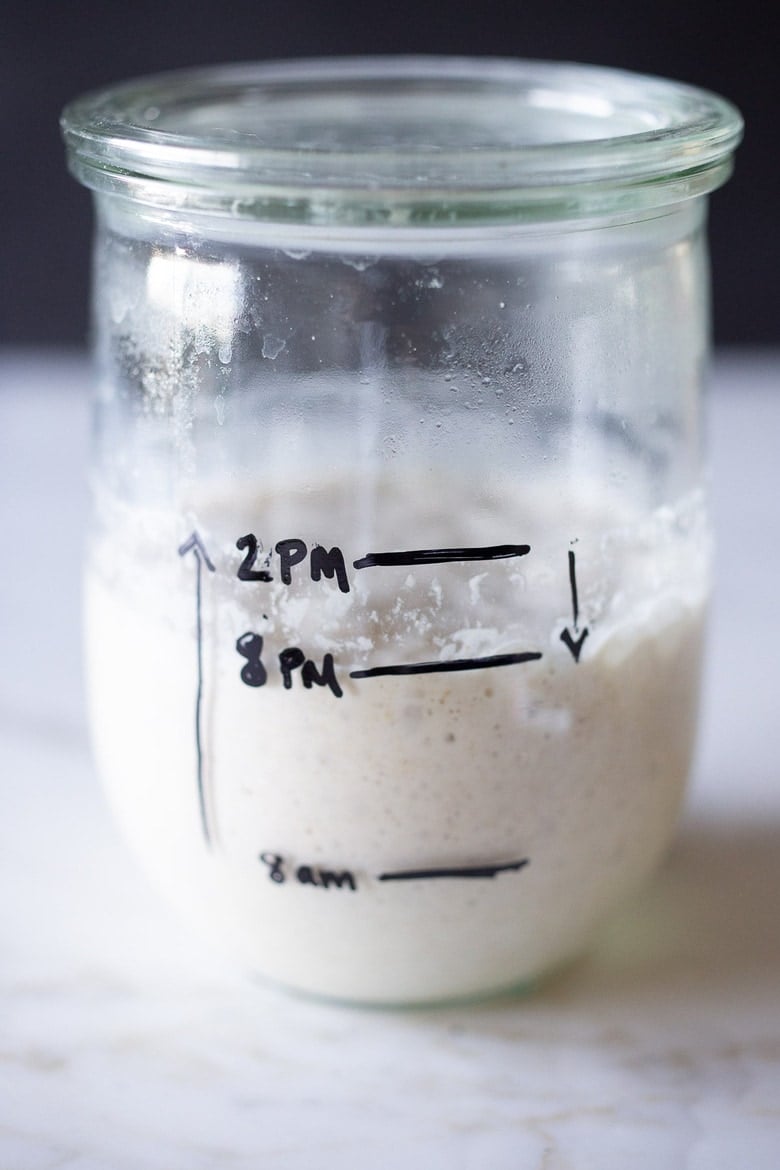
In the photo above, on the 6th day, the starter was fed at 8 am, it peaked around 2 pm, then it started deflating, and by 8 pm, it was “hungry” again. See those downward “slide” marks on the jar?
DO THE FLOAT TEST: When the starter is at its peak, or just after, place a teaspoon of starter (just from the top, don’t stir it down) in a glass full of water; it should hopefully float. If it floats, success!!! Congrats. You can now make our sourdough bread…tonight!
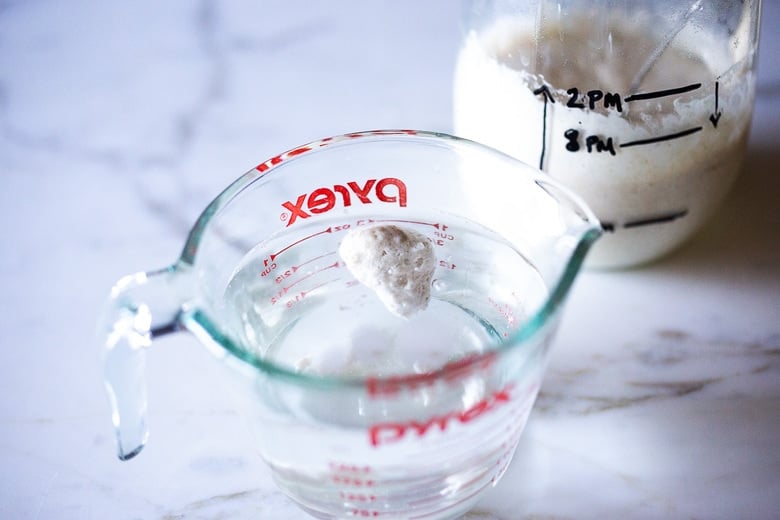
TIP #5: When baking bread always use hungry starter that has already peaked!
STARTER DOES NOT FLOAT? If it doubles in size but does not float, you can still try baking a loaf if it doubles within 6-8 hours of feeding it.
At this point, if your starter does not double in size within 6-8 hours of feeding, don’t give up! Often, it just takes longer, especially during the winter months. Continue feeding one to two times a day until you see a consistent, predictable rise and fall.
Read the troubleshooting section. If you need to take a break, put it in the fridge and try it again up to a week later. Don’t toss it!
Day 6 Evening: Let’s Bake! Use 1/3 cup starter to make this sourdough bread recipe and place the remaining starter (or if not making bread, place all of it) in the refrigerator, and feed it at least once a week, reserving ½ cup starter, before feeding it the usual 1 cup bread flour, 1/2 cup water.
TROUBLESHOOTING Starter
- SMELL: Starter should smell sweet, tangy, earthy, like a wet horse – not “bad”. If it really smells foul or unpleasant, you may have used an unclean jar, unclean utensil, or somehow introduced other bad bacteria. I would start over.
- NO ACTION: On day 4-5 it is typically for it to slow down. If your starter is not rising at all but there is evidence of hunger (liquid at the top, or bubbles) try 3 things. First substitute 1/4 cup whole grain flour (add to ¾ cup white bread flour) on your next feeding. If no rise, then try using mineral water, specifically San Pellegrino instead of water. San Pelligrino specifically has the right mineral ratio, I have great luck with it. Others not so much! Also try stirring the starter a couple of hours after feeding, a couple of times throughout the day to allow wild yeast from the room to get in there. Lastly, you could try pineapple juice instead of water.
- FLOUR: Try to use fresh milled whole grain flour to start, then organic BREAD FLOUR. The more wild yeast in the flour, the better your starter will do- so smaller brands like Bob’s Red Mill seem to do better than bigger conventional brands that have been overly processed. It is totally OK to mix flours and to switch them up- this adds different kinds of wild yeast- a good thing!
- DO NOT overfeed. For example, maybe feeding 2 x day at 12-hour intervals is too often. You want to feed after the starter has peaked, then deflated (see photo above- you’ll see some slide marks on the jar) and this tells you that it is hungry. If you feed the starter before it has had a chance to metabolize (or eat) all the flour (before peaking) and then you discard part of it, and feed it again, you are actually diluting all that amazing bacteria, weakening your starter. So it’s all about watching your starter in your home. If you are not seeing rising and falling, but notice the starter just gets liquidy, this too is a sign of “hunger”. Or if it gets runny enough to pour out of the jar, another sign it is hungry. There are lots of variables here. Just be patient, pay attention and watch. This is a living thing- it doesn’t care about time schedules and recipes or what it “should” do. It will “eat” when it is “hungry” and sometimes it likes to eat slowly. 😉
- TIME: It may take longer than 6 days in colder environments. Use a kitchen thermometer and take its temp. Is it over 65F? Find a place where it can be warm. In the oven with the light on, or in an upper cupboard ( heat rises). Sometimes it takes 12-14 days! Be patient, keep going. If it is doing absolutely nothing, leave it out on the counter for 24-48 hours and see what happens. If you run out of flour or need a break, don’t just toss it, put it in the fridge and see if you can get it going a few days later.
- ACIDITY: If you still can’t get that starter going, some people recommend subbing pineapple juice for the water for one feeding- raising the acidity level. My good friend just tried this and it got hers going.
- LIQUID: If you see any liquid at the top of your starter, it means your starter is hungry. So, yes it’s still alive which is a good thing! You can stir the liquid in, or pour the liquid out, either way, but feed it. This is a sign that you may need to feed it more often.
- MOLD: if you see any discoloring or mold on the surface, starter was probably contaminated. If it is only on the surface, it is probably ok to save. Scrape it off, save 1/2 cup of the underneath starter, and keep going, using a clean jar. Feed, smell, use your best judgment.
- FLOAT TEST: Try testing when your starter is peaking. Take a spoonful from the top without stirring it down. If your starter is rising and falling consistently, but not passing the float test and it has been over 8-10 days- just try baking a loaf. People are having luck with good loaves without passing the float test. It may be the flour…
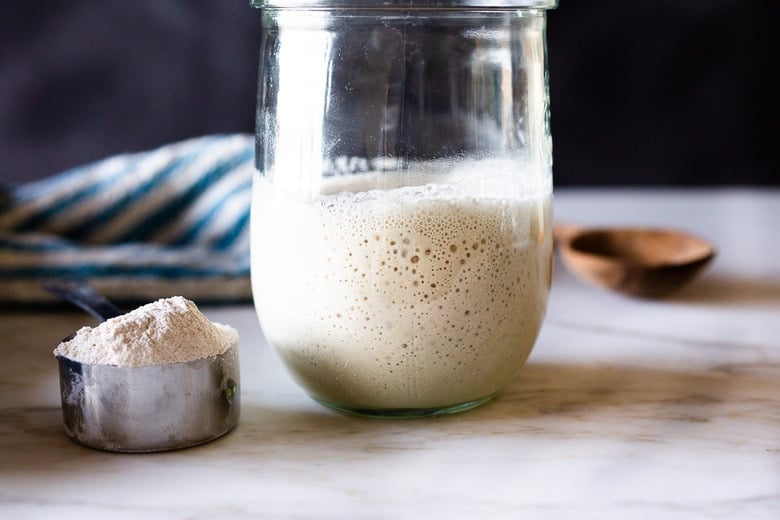
How to Maintain Your Starter
- REFRIGERATE & FEED AT LEAST ONCE A WEEK: Pick a scheduled day and try to stick with it, always reserving 1/2 cup and feeding it 1 cup flour and 1/2 cup water. Discard the remaining, give it away, or keep the discard in a separate container for sourdough pancakes, sourdough buns, banana bread, biscuits, etc. I usually don’t feed the discard unless I give it away.
- If you forget to feed it one week, it is most likely OK; feed it 1-2 times a day for 1-3 days in a row to revive it (keeping it out on the counter) until bubbly and active and doubles within 6 hours. I’ve left my starter for a month on vacation (in the fridge) without feeding and simply revived it by feeding it 3 days in a row, 1-2 x day. It’s surprisingly hard to kill. You can also freeze it for more extended storage.
- This batch will allow you to bake 2 loaves of bread per week with enough left to feed for the next week. If you want to bake more often, you can keep it out and feed it 1-2 x daily. Or if baking every few days, you can pull it out of the fridge, feed it 10 hours before using, leaving it out, use what you need while it is peaking (or slightly after), then put it back in the fridge that evening. Do the same thing a few days later when ready to use again. So this would be feeding 2-3 times a week, best if baking 4-5 times a week.
The best time to use sourdough starter is just after it peaks or on its way down when you know it is hungry.
Sourdough Bread Starter FAQs
Yes. While you are building your starter, during the first week, it is the simplest, easiest, fastest, and most economical way to create a healthy starter. (Or save it separately -in the fridge- and use it in Pancakes, Waffles, Buns, or Biscuits. ) This is because you always have to feed it two times its volume in flour. For example-if you kept all the 1 1/2 cups of starter, you would have to feed it 3 cups of flour (instead of keeping just a 1/2 cup and only feeding it ONE cup). Discarding will shorten the fermentation process, require less flour in the long run, and create a stronger starter. Once your starter is “established” after the first week- then you can give it away to friends, use it in pizza dough, pancakes, etc) or give it to a friend.
How to use your Sourdough Starter
- See all our Sourdough Recipes!
- Sourdough Scones
- Sourdough Crackers
- Sourdough Biscuits
- Sourdough Buns
- Sourdough Tortillas!
- Vegan Banana Bread
- Overnight Sourdough Waffles
More from Feasting At Home
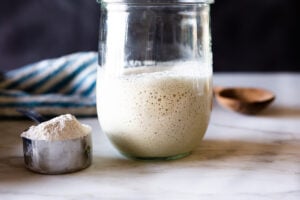
Simple Sourdough Starter
- Prep Time: 30
- Cook Time: 6 days
- Total Time: 144 hours 30 minutes
- Yield: 1 ½ cups
- Category: sourdough, fermented, cultured, bread, baking,
- Method: fermented
- Cuisine: bread
- Diet: Vegan
Description
How to make your own Sourdough Starter (see the step-by-step video in post) using simple ingredients with no special equipment, in 6 days, that can be used in sourdough bread. Sourdough Starter is a wild yeast, made from fermenting flour and water.
Ingredients
- 120 grams whole grain flour (whole wheat flour, rye flour, or freshly milled flour) 1 cup, fluffed, spooned and leveled
- Organic White Bread Flour (5-10 lb bag ) I like Shepherd’s Grain or Bob’s Red Mill.
- 120 grams Water per feeding (1/2 cup water)
Instructions
-
- Day 1: Starting in the morning or at night, using a wide-mouth quart jar or Crock or Glass Measuring Cup mix 1 cup whole grain flour (120 grams) with 1/2 cup (120 grams) filtered water using a fork making sure you’ve incorporated all the dry flour. For your first measuring – it is a good idea to weigh the flour, using a kitchen scale so you get an idea of how thick it should feel. It should be like a thick paste. Thick like peanut butter. If you need to add a little more water to incorporate the flour, that is OK, but be precise with the flour. Place the lid on top (using the Weck jar is really handy here) or a damp towel to keep moisture in, or plastic wrap- and let sit at room temperature (70-80 degrees) on the kitchen counter for 24-48 hours, or until you see some bubbling. If you are not sure how warm it is, use a kitchen thermometer and check it a few hours later. See notes for TEMPERATURE.
- Day 2: After the first 24 hours, you may or may not see a bit of bubbling. I prefer to let this rest until I see a tiny bit of activity (bubbles) and sometimes this takes 36 or up to 48 hours. So start “day 2”, when you see a little bit of bubbing. Discard all but 1/2 cup (136 grams) of the starter. (See notes for discard). Add to the remainder, 1 cup of white bread flour, (120 grams), spooned and leveled, and 1/2 cup filtered water (120 grams), mixing well with a fork. Place the lid on loosely again and allow the mixture to sit at room temperature (70-80F) for another 24 hours.
- Day 3: By the third day, you should definitely see some bubbling- and if not, let it go a bit longer. Depending on how warm your house is and how active your starter, you may need to begin feeding more often, or even move to two feedings a day roughly 12 hours apart, like in the morning and at night. In a nutshell, you want to feed the starter only after it has peaked (metabolized all the flour from the last feeding) and has started sinking down or gets liquidy- this is when it is hungry! This might be 12 hours, it might be 14, it might be 18, or 24, depending on the temp in your house. In very warm climates it may only be 8 hours. It is better to underfeed rather than overfeed here. For each feeding, like before, discard all but 1/2 cup of the STARTER (keeping roughly ½-cup of starter in the jar -4 ounces or 136 grams) Add 1 cup Bread Flour (spooned and leveled) and 1/2 cup water to the 1/2 cup starter and let this rest at room temperature for 12-24 hours or until the starter looks “hungry” again before repeating.
- Day 4: Feed 1-2 times, discarding all but 1/2 cup of starter EACH TIME. Feed 1 cup bread flour, 1/2 cup water. Look for the hunger signs. Hopefully, you’ll begin to see some rising and falling. It’s helpful to put the starter in a clean jar and mark the beginning level (with sharpie, string or rubber band) so you can easily see this. ***If for some reason your starter looks like it is still rising at the time of second feeding (at night) and there is no evidence it has fallen or no slide marks, it is still “eating” so skip this feeding and feed first thing in the morning. AGAIN, Feeding it when it is “not hungry” will basically dilute all the growing yeast and make it lethargic. Better to starve than overfeed.
- Day 5: Feed again, 1-2 times, roughly 12 hours apart, or when hungry, discarding all but a 1/2 cup the starter EACH TIME. 1 cup bread flour, 1/2 cup lukewarm water. The starter should look active, bubbling, rising, sliding down, hopefully, close to doubling in size. (If not, repeat this day until starter doubles in size within 8-12 hours of feeding- and read the troubleshooting section.)
- DAY 6: Give it one last feeding. Discard all but a 1/3 cup. Add 1 cup flour ( 120 grams) and 1/2 cup water, and place it in a clean jar so you can see the action clearly. You can use a sharpie or place a rubber band around the jar to mark the beginning level. The starter should hopefully double in volume within 6 hours of feeding. When it peaks, DO THE FLOAT TEST: To test the starter, place a teaspoon of starter (just from the top, while it is peaking, don’t stir it down) in a glass full of water, it should hopefully float. If it does, you can make sourdough bread. Tonight! Let the starter keep resting at room temperature or a few more hours allowing it to fully metabolize the flour, perhaps sinking a little before making your dough. You want to make dough with slightly hungry starter. Place the remaining starter in the fridge and feed it in a week. You’ll have enough stater to make one more sourdough loaf during the week, and still have enough to feed. If you want to wait to make bread until later in the week place starter in the fridge. Be sure to feed it in 7 days. Read maintenance section.
- At this point, if your starter does not double in size don’t give up! Often it just takes longer, sometimes up to two weeks, especially if it’s cold. Continue feeding one-two times a day (only when hungry) for a few more days, until you see a visible rise and fall. Read the troubleshooting section. If you need to take a break, just put it in the fridge and try it again up to a week later. Don’t toss it- if there are bubbles, it is still alive.
- This batch of starter will make two loaves of bread with enough left over to feed for the following week.
Notes
- TEMPERATURE: The colder your home, the longer it will take for the starter to grow and become active (bubbles). Find a warm spot (70-80 degrees) for the best results. On the stovetop, with the light turned on, or on top of the fridge. Or in the oven with the light on. On top of a heating pad (set to low) with a towel in between). You can still make the starter in a colder home, it will just take longer- even up to 2 weeks.
- FLOUR: Always try to start the batch by using organic, freshly milled whole-grain flour (wheat or rye) because it has more wild yeast in it than All-Purpose or white flour and will get it active and growing sooner. You can, of course, continue to use whole grain, but I’ve had the best luck using organic “bread” flour for days 2 through 6. People have made a sourdough starter with All-Purpose flour- but personally, this has never worked for me– there are fewer nutrients and wild yeasts in the flour and results in a very lethargic starter. If it is your only option, try mixing in 2+ tablespoons of whole-grain (wheat or rye) with the AP flour per feeding. Feel free to use different flours or mix different flours together. It is OK to use all-purpose flour if in a pinch, but using it repeatedly will result in sad starter.
- WATER: I usually use tap water -but sometimes the chlorine in tap water can inhibit the growth of your starter. Lukewarm water helps fermentation to start faster. Sterilized bottled water is often overly sterile, and can also inhibit. Mineral water, like Perrier (carbonated is OK) can sometimes work miracles.
- HYDRATION: Hydration refers to the ratio of water to flour in terms of weight. It is a ratio. The starter is typically at 100% hydration- meaning equal parts flour and water, in terms of weight. So if you use 120 grams of water, use 120 grams of flour. This roughly translates to 1 cup of flour and 1/2 cup water. Feel free to weigh instead of measure if you want to be more precise, or want to familiarize yourself with the consistency you are aiming for. If using whole grain flours (which tend to be “thirstier”) and your starter seems very thick, it is totally OK to add more water to thin it a bit. I intentionally keep the hydration a little lower here (a thicker starter) so you can more clearly see the rise and fall “action” in the jar.
- STORING AND FEEDING: When your starter is kept cold, in the fridge, you don’t need to feed it as often- only once a week. Feel free to feed it “cold”, and put it right back in the fridge if you like. If you keep it out on the counter, you’ll likely need to feed it 1-2 x daily (or just watch and feed only when hungry). Cold slows down the fermentation, heat speeds it up.
- USING: When you need to use your starter for baking bread, feed it 10-12 hours before making bread dough, using it after its peak height. For a more “sour” flavored bread, use the starter straight from the fridge, 3-6 days after feeding. The starter gets more sour tasting the longer it goes without feeding. Feeding the starter the same day as making bread will produce a milder sourdough flavor.
Nutrition
- Serving Size: 1 tablespoon
- Calories: 31
- Sugar: 0 g
- Sodium: 0.2 mg
- Fat: 0.1 g
- Saturated Fat: 0 g
- Trans Fat:
- Carbohydrates: 6.2 g
- Fiber: 0.2 g
- Protein: 1 g
- Cholesterol: 0 mg
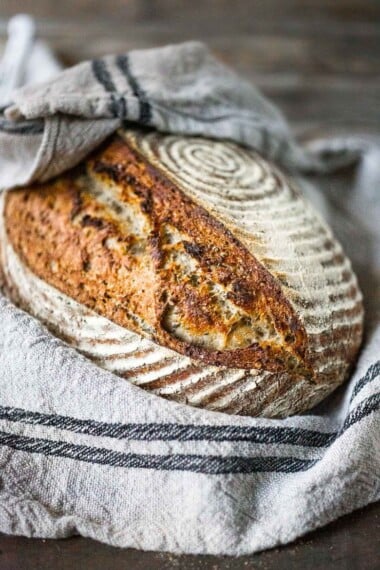

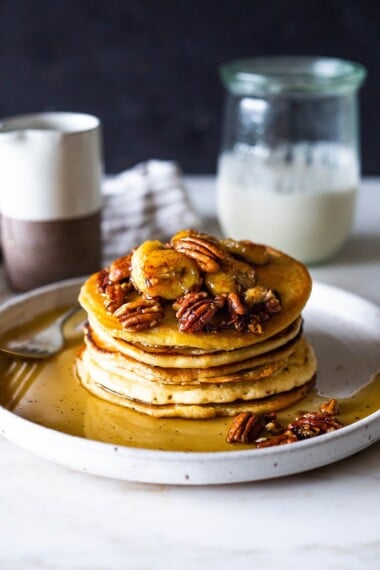
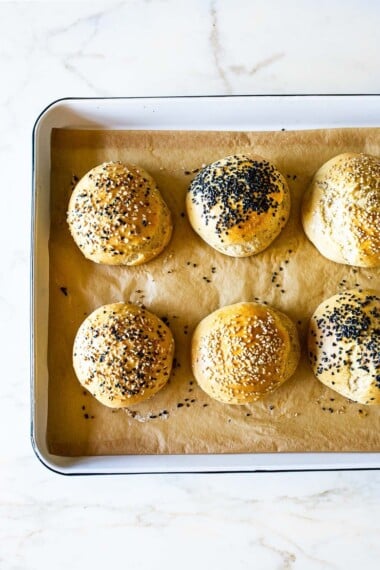

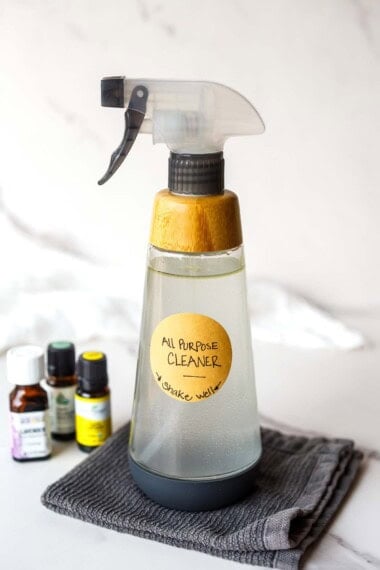
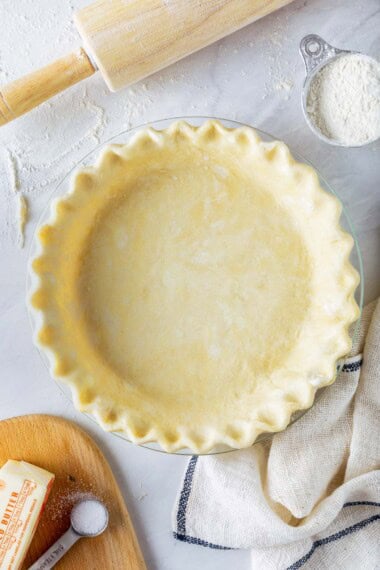
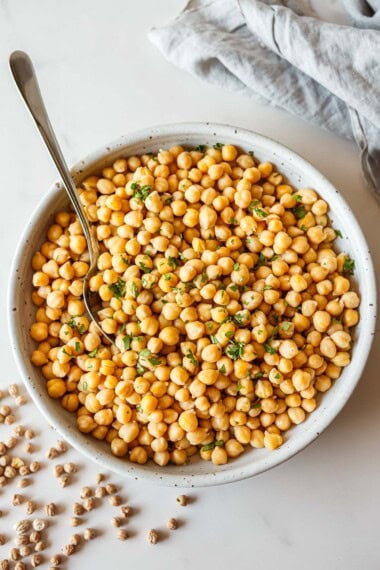



This is Day 2
I feed starter at 11 00 and at 2 30 it tripled!!!
What do I do?
Move it somewhere cooler and feed after it sinks down. keep going. 🙂
I would love to see the video. Want to start making injera, but can’t get the sound to play on iPad. Don’t see inmate icon near the video. Sorry, Dorothy
Is your ad blocker off?
I have made a loaf of your bread recipe and it was a success. We loved it. Thank you so much for the recipe. My question is: when I feed the starter on a week that I don’t use it do I let it rise and then put it in the fridge or put it in the fridge right after I fed it. It over doubles its size in around four hours.
Thanks Sandra, You can put it straight in the fridge!
Hi! Do you think you may have a pizza dough recipe for this starter in the near future? 😬
Yes I have one, just have to post it!
Hey, Sylvia!
Thank you so much for sharing this wonderful starter recipe! I’m on day 6 and am concerned I may have ruined my starter.
The day 6 instructions above say to discard all but 1/3 cup of the starter, which is different than the day 1-5 instructions of a 1/2 cup (maybe a typo?). I followed this instruction (and fed with the 120g method this morning) but now my starter is liquidy and has only risen about 1/2” after 9 hours. I just tested it in water and the starter sunk straight to the bottom of the cup.
Is it possible to salvage my starter from here? For reference, I’m using bread flour and filtered water.
Thanks in advance for your guidance!
Yes Andrea, not a typo. 1/3 cup. It is most likely fine. How about adding a little whole grain at next feeding? Give it more time, yes it is salvageable.
Hi Sylvia,
Thank you for this recipe! I’ve been growing my starter for about 3 weeks now and am wondering if it’s ready to bake with. It doesn’t double within 4-6hrs of feeding like you said it should, but it doubles after about 20hrs and does pass the float test. So far, I’ve been feeding it once a day (it never reached the point of feeding twice a day). Is my starter ready for baking, or should I grow it more? Thank you!
Well, that is a great question. You know, if it were me, I’d give it a try!
I tried baking a loaf this morning, and the starter worked well! The finished loaf could use more troubleshooting (i.e. it didn’t rise as well as I had hoped), but the pleasant sourdough flavor was there. 🙂
Great! sometimes it takes a few tries!
I can’t find the video
You may need to turn your ad blocker off.
Thanks for the recipe!!!! I had a question, my starter beggins double its size two days ago, it doesnt pass the flotation test, so I keep feeding it twice a day, but yesterday I noticed a beer smell, can that be fixed?
It the fermentation smell- it should be ok. 🙂
Hi, I just started this yesterday. It’s been about 24hrs. There’s a lot of bubbling and has almost doubled in size. Should I feed it now or wait for the bubbling to go down? Thanks for the help.
Wait for it to go down and get hungry 🙂
My first day and the starter has already tripled in size. It also has a strong feet smell. Should I discard and start over?
I used general purpose flour and last night it was particularly warm.
😂 Was the jar clean? If so, it is probably ok? Just keep going and see how it does.
I’ve been studying sourdough by reading posts on numerous websites. I’ve been feeding my starter twice a day for five weeks. This weekend, I used your post and recipe and I made the most beautiful loaf of sourdough bread with the most open crumb and amazing flavor!!! Success! Thank you so much for your thoughtful post and helpful tips. I wish I could post the picture. It’s glorious. Thank you.
I’m so happy it worked for you Pam- congrats!
I have a mature starter now, I have put it in the refrigerator. If I want to make bread every Saturday, is this the process?
Friday evening at 8:00 P, I use starter cold from the jar to get my dough going for the overnight rise. When I remove the 1/3 c., I feed my starter and put it back in the refrigerator (1/3 c. starter, 1 c. flour and 1/2 c. water). Right?
Thanks again so much!!!! I so appreciate your blog and sourdough post. It looks like many other do as well!
Yep Pam! You got it!!!
I have the process down and I’m making sourdough bread every weekend. One loaf for us and one to share! I can’t thank you enough.
That is awesome Pam! high five 🙌 Great to hear!
I am loving this recipe! Thank you. I am wondering if you have gotten your new scale…. I have read several different gram equivalents…what gram measurement would you use for the 1/2 cup reserve starter? Thanks.
136 grams!
Thanks for this recipe!
I started mine yesterday and fed it for the first time today. It’s only been about 3.5 hours since I fed it and it has already more than doubled in size. Is this normal? Should I still wait the full 24 hours to feed again, or do it sooner? I live in LA so it’s a pretty warm environment. Thanks in advance for the help!
Hi Erin, it sounds happy and active, and yes warm there. Yes, go ahead and feed it if looks “hungry”. It shouldn’t die if you want to wait though. I’d at least wait 12 hours.
Thanks for the reply, It sunk back down and I fed it again about 20 hours later (day 3) later that evening I noticed it hadn’t grown, but just had liquid on the top. I fed it again and today there has been no growth/change. I think I might have overfed it? Is there a way to come back from that? Or just discard and start over?
If you think you overfed it, just wait longer before feeding next time. If it is runny, to the point that you can pour it right out of the jar, it is hungry.
Thanks so much! It was really runny, just didn’t rise. I appreciate the feedback!
So runny means it is hungry- so it did process the flour. It is still alive! Could you try a different flour?
I had been using regular white bread flour and then last night I mixed in some whole wheat. This morning was the same, the starter was runny but still no rise. Should I keep using the mixture? Or switch completely?
Can you try this? Save 1/2 cup starter, mix it with a mixture of 1 cup flour, 1/2 cup water and place it in a new clean jar. Snap a photo of it 12 hours later and send it to me? sylvia@feastingathome.com. or on Instagram messages. Just getting curious here. 🙂
I finally got it to start rising! Thursday afternoon it was watery again without rise so I decided to just to stir and add some flour to thicken it up but not do an actual feeding. After this, I waited 24 hours and saw a little rise (not quite double) on Friday and fed it again the regular way. I waited another 24 hours and it was just about doubled in size on Saturday. I fed again about 2pm on Saturday and this morning (Sunday) around 7:45am I could see that it had risen and slid down a bit over night. I fed it at that time and it doubled in about 8 hours. We’re at the 8.5 hour mark now and there hasn’t been any change since it doubled (no rise or fall), but it definitely seems more promising! Thanks again for all your help/feedback. I can’t wait to try baking it soon!
*For the feedings, I’ve continued using a mix of whole wheat and bread flour (50g whole wheat, 70g bread flour)
Great Erin! Nicely done. Keep going!
I was successful with the starter – it doubled in size; and passed the spoon drop test. When I made bread – I used the starter when it was at its peak.
The bread did not rise – so my bread was a flop.
Afterwards, I put 1/2 cup in a clean jar and fed it.
It has come out of the jar twice. I now have it in a half gallon jar.
I have concluded that my starter is lethargic and that I should not have used it in my receipt when it was at its peak!
I also should not have fed it.
Please help! I am desperate to find what I did wrong!
Thank You, Betty
Your starter doesn’t sound lethargic at all. It seems happy if it is coming out of the jar. What is the temperature in your kitchen when you let the bread proof overnight? I wonder if it over proofed? Was the dough runny or firm in the morning? On your next try, make sure to let your starter get a little hungry,(use after it peaks) before using it for bread the next time. Don’t give up, you are very close. Sometimes it takes a couple tries to get it tweaked to your particular kitchen and environment.;)
I actually have 2 questions. When you keep your starter, when finished, in the refrigerator, do you keep it loosely covered or tightly covered? And my 2nd question is, when you discard the amount in the last step, if I take 1/2 cup of the discard & feed it so I can give it to a friend, do they have to do all those steps or is it ready to bake with? My 1st sourdough loaf just came out of the oven I hope it tastes as good as it looks!
Great to hear! Keep the starter loosley covered. If you give your friend a 1/2 cup of your discard starter, it should be good to use, but I would recommend you have them feed it (if you think it is hungry) so they can keep it going and not use it all up in one loaf.
Hi!
Could you clarify what you mean by “Day 6…………The starter should hopefully double in volume within 4-6 hours of feeding. Let the starter rest at room temperature for 8 hours; it should be active, with bubbles throughout or breaking the surface. ”
I presume you include the 4-6 hours WITHIN the 8 hours of rest on the counter?
My starter doubles, is able to float in water, and peaks after about 6 hours.
Your no-knead sourdough recipe says to use the starter right after it peaks but in my case it would be way earlier than say 8pm if i fed my starter at 8am.
I’m currently 3 hours in and it’s about halfway to doubling.
Any thoughts?
Thanks for your recipes, the pancakes and scones were delicious (I added chocolate chips :))
I prefer to make bread with really hungry starter. That way your loaf will be nice and airy. So using it after it peaks will ensure it is hungry. 🙂 So let it rest on the counter roughly 8 hours and hopefully, it will have peaked at hour 4 to 6 and is sliding back down by hour 8. It doesn’t have to be exact. Key is a hungry starter.
Sylvia, HELP! I’m on day 14 and have now gone 48 hours with no growth at all 🙁 There’s liquid at the top but now the bubbles have kind of collapsed. Our house stays between 71-78 degrees, I’ve tried wrapping the jar in a towel, keeping it in particularly warm areas, nothing’s working. Is it just dead at this point? Since it hasn’t grown at all in the last 48 hrs, I don’t want to feed it since I assume it isn’t hungry. Should I just start over?? (I’ve made great recipes from the discard tho!)
If there is liquid at the top, it is hungry. You don’t need to wrap it, your home is warm enough. Look for those slide marks. 🙂 My guess is it is rising and falling without you noticing. Would it pour out of the jar if you tilted it in this state? If so, it is hungry.
I’m approaching Day 5 of my starter. Every day it bubbles and gets “hungry”. But I’m concerned because it says by this time I should have several days of feeding twice a day, but that has not been the case. Should I do anything different??
I would just keep doing what you are doing! Are you using bread flour?
I was able to successfully make one sourdough bread from this but then it seems my dough ‘died’ as it did not pass the ‘float’ test. I have been trying to feed it again, discarding as you explain, and have not been successful in getting it back. Can you explain/assist?
Hi, don’t worry too much about floating, if it is doubling within 6 hours after feeding.
Hi Sylvia,
Have made your sourdough a few times now and I always enjoy following the steps on your videos. Such enjoyment pulling a loaf out of the oven… all the way in Australia. And my starter seems to keep going after being in fridge then feeding it when needed.
Thank you, you seem like such a lovely person.
Hi Sylvia!
Thank you for all your amazing recipes. I have tried so many starters and never got them to work until yours. So thank you!
I’m on day 9, waiting for the float test. Today my starter outgrew my jar. What did I do wrong? It also doesn’t smell as sour but smells faintly sour and tangy. I think i wasn’t letting it eat all the flour. Please help! And thank you!
Do you mean it after you fed it, it rose out of the jar? Or in general, there is too much starter to fit the jar? If it rose out, this is a good thing. It is happy and alive. 🙂
Oh yay! Thank you so much for sharing with us! I made your sd pancakes today and it has changed our lives. Never will we eat boring pancakes again!
Haha! Love it!
I’m on my day 2 of feeding new starter and it bubbled out of the quart jar within 4 hours of feeding. Is this ok and what do I need to do. Seems kinda quick but didn’t know if I should feed again or wait till day 3 to feed again
Hi Patty, it is just very happy. 🙂 Feed it when it sinks down again.
Never had success with a sourdough starter until following your directions. I found your troubleshooting section really helpful and the videos! Thanks for being so thorough. I have been saving up my discarded starter and have made your pancake recipe a few times. We LOVE it! With that said, how long does the discard last stored in the fridge?
Great it hear! It keeps indefinitely, as long as it is fed weekly.
Are you referring to the starter or the discard? Is there a known amount of time it’s okay to store the discard in the fridge and still use it in other recipes?
The starter! If the discard looks discolored I don’t use it. But if I am continually adding to the discard, and continually using it, it can go quite a long time. I guess it just depends how active you are with it. Sometimes if I know I’ll need a batch of it for something I’ll just feed the discard a little flour to revive.
Hi again!
I have 2 new questions:
1. I have always used AP flour and I just added 1/2 cup wheat to my last loaf. I have fed the starter several times already and it is waiting in my refrig. For my next feeding can I add some wheat flour? Or do I only add wheat to loaf recipe? If to loaf recipe, can I increase the amount of wheat to 1 cup?
2. I have bought a stone baker pan with lid to make a loaf and the instructions say to put the dough into a pre- heated baking pan ONLY if dough is room temp. How do I do this with your recipe instructions? You have the dough in the refrig while the pan/oven is pre-heating.
Thanks for the opportunity to communicate with you on these issues. I am SOOOO enjoying this recipe! You have made it so easy and CLEAR!
Hi Susan! You can add whole wheat to your starter, no problem. Feel free to leave the bread out while the baker heats up. Not a problem. I would double check the max heat level for the baker if is stoneware. 500 is probably too high- they do crack.
Thanks so much for your responses!
🙂
I am loving this recipe! Thank you. One question…is there a reason you give most measurements in grams except for the reserve 1/2 cup (4 ounces)? I have read several different gram equivalents…what gram measurement would you use for the 1/2 cup reserve starter? Thanks.
Hi Tracie- I will add. My scale is broken, waiting for a new one!
thank you!
Any chance you have the gram equivalent of the 1/4 cup? thanks. Tracie
Sure. But the 1/4 cup of what?
I am loving this recipe! Thank you. One question…is there a reason you give most measurements in grams except for the reserve 1/2 cup (4 ounces)? I have read several different gram equivalents…what gram measurement would you use for the 1/2 cup reserve starter? Thanks.
This was the article that got my starter off the ground. Really helped me understand what I was trying to do. I enjoy the process of keeping it healthy, and found a love of making pizza. Loaves are fun, but still a little stressful. Thanks for everything and especially the video!
Glad this worked for you Sam!